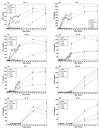Temporal sequence and kinetics of proinflammatory and anti-inflammatory cytokine secretion induced by toxic shock syndrome toxin 1 in human peripheral blood mononuclear cells
- PMID: 11705931
- PMCID: PMC98845
- DOI: 10.1128/IAI.69.12.7544-7549.2001
Temporal sequence and kinetics of proinflammatory and anti-inflammatory cytokine secretion induced by toxic shock syndrome toxin 1 in human peripheral blood mononuclear cells
Abstract
The staphylococcal superantigen toxic shock syndrome toxin 1 (TSST-1) induces massive cytokine production, which is believed to be the key factor in the pathogenesis of TSS. The temporal sequence and kinetics of both proinflammatory and anti-inflammatory cytokines induced by TSST-1 in human peripheral blood mononuclear cells were investigated. A panel of loss-of-function single-amino-acid-substitution mutants of TSST-1, previously demonstrated to be defective in either major histocompatibility complex (MHC) class II binding (G31R) or T-cell receptor (TCR) interaction (H135A, S14N), was studied in parallel to further elucidate the mechanisms of cytokine secretion. Wild-type recombinant (WT r) TSST-1 induced a biphasic pattern of cytokine secretion: an early phase with rapid release of proinflammatory cytokines (especially gamma interferon, interleukin-2 [IL-2], and tumor necrosis factor alpha [TNF-alpha]) within 3 to 4 h poststimulation, and a later phase with more gradual production of both proinflammatory (IL-1beta, IL-12, and TNF-beta) and anti-inflammatory (IL-6, IL-10) cytokines within 16 to 72 h poststimulation. G31R, which is defective in MHC class II binding, induced a cytokine profile similar to that of WT rTSST-1, except that secretion of the early-phase proinflammatory cytokines was delayed and production of IL-1beta and IL-12 was markedly reduced. In contrast, mutant toxins defective in TCR interaction either demonstrated complete absence of any cytokine secretion during the entire observation period (H135A) or resulted in complete abolishment of IL-2 and other early-phase proinflammatory cytokines, while secretion of IL-10 appeared unaffected (S14N). Neither WT rTSST-1 nor the mutant toxins induced IL-4 or transforming growth factor beta. Our data indicate that effective TCR interaction is critical for the induction of the early-phase proinflammatory cytokine response, thus underscoring the importance of T-cell signaling in TSS.
Figures

Similar articles
-
Temporal sequence and functional implications of V beta-specific T cell receptor down-regulation and costimulatory molecule expression following in vitro stimulation with the staphylococcal superantigen Toxic shock syndrome toxin-1.J Infect Dis. 2002 Feb 15;185(4):555-60. doi: 10.1086/338634. Epub 2002 Jan 22. J Infect Dis. 2002. PMID: 11865410
-
Toxic shock syndrome toxin-1-induced death is prevented by CTLA4Ig.J Immunol. 1996 Nov 1;157(9):3869-75. J Immunol. 1996. PMID: 8892617
-
Human peripheral gammadelta T cells potentiate the early proinflammatory cytokine response to staphylococcal toxic shock syndrome toxin-1.J Infect Dis. 2004 May 15;189(10):1892-6. doi: 10.1086/383478. Epub 2004 Apr 26. J Infect Dis. 2004. PMID: 15122526
-
Regulation of helper T cell responses to staphylococcal superantigens.Eur Cytokine Netw. 2001 Apr-Jun;12(2):210-22. Eur Cytokine Netw. 2001. PMID: 11399508 Review.
-
Staphylococcal Superantigens: Pyrogenic Toxins Induce Toxic Shock.Toxins (Basel). 2019 Mar 23;11(3):178. doi: 10.3390/toxins11030178. Toxins (Basel). 2019. PMID: 30909619 Free PMC article. Review.
Cited by
-
Superantigen-mediated differentiation of bovine monocytes into dendritic cells.J Leukoc Biol. 2009 Apr;85(4):606-16. doi: 10.1189/jlb.0608338. Epub 2009 Jan 7. J Leukoc Biol. 2009. PMID: 19129485 Free PMC article.
-
Beta-(1-->3)-D-glucan modulates DNA binding of nuclear factors kappaB, AT and IL-6 leading to an anti-inflammatory shift of the IL-1beta/IL-1 receptor antagonist ratio.BMC Immunol. 2006 Mar 22;7:5. doi: 10.1186/1471-2172-7-5. BMC Immunol. 2006. PMID: 16553947 Free PMC article.
-
TCR-Engineered Lymphocytes Targeting NY-ESO-1: In Vitro Assessment of Cytotoxicity against Tumors.Biomedicines. 2023 Oct 16;11(10):2805. doi: 10.3390/biomedicines11102805. Biomedicines. 2023. PMID: 37893178 Free PMC article.
-
Air particulate matter SRM 1648a primes macrophages to hyperinflammatory response after LPS stimulation.Inflamm Res. 2018 Sep;67(9):765-776. doi: 10.1007/s00011-018-1165-4. Epub 2018 Jun 19. Inflamm Res. 2018. PMID: 29922853 Free PMC article.
-
Staphylococcal superantigen (TSST-1) mutant analysis reveals that t cell activation is required for biological effects in the rabbit including the cytokine storm.Toxins (Basel). 2010 Sep;2(9):2272-88. doi: 10.3390/toxins2092272. Epub 2010 Sep 9. Toxins (Basel). 2010. PMID: 22069685 Free PMC article.
References
-
- Abbas A K, Murphy K M, Sher A. Functional diversity of helper T lymphocytes. Nature. 1996;383:787–793. - PubMed
-
- Aste-Amezaga M, Ma X, Sartori A, Trinchieri G. Molecular mechanisms of the induction of IL-12 and its inhibition by IL-10. J Immunol. 1998;160:5936–5944. - PubMed
-
- Bergdoll M S, Crass B A, Reiser R F, Robbins R N, Davis J P. A new staphylococcal enterotoxin, enterotoxin F, associated with toxic-shock syndrome Staphylococcus aureus isolates. Lancet. 1981;i:1017–1020. - PubMed
-
- Billiau A, Heremans H, Vermeire K, Matthys P. Immunomodulatory properties of interferon-gamma. An update. Ann N Y Acad Sci. 1998;856:22–32. - PubMed
-
- Bogdan C, Paik J, Vodovotz Y, Nathan C. Contrasting mechanisms for suppression of macrophage cytokine release by transforming growth factor-beta and interleukin-10. J Biol Chem. 1992;267:23301–23308. - PubMed
Publication types
MeSH terms
Substances
LinkOut - more resources
Full Text Sources
Research Materials

